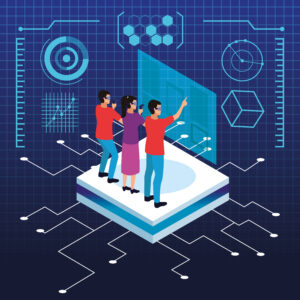Through bridging the gap between the real world and the virtual one, virtual reality (VR) and augmented reality (AR) have transformed the way we engage with digital material. Numerous new opportunities have been made possible by these immersive technology in a variety of fields, including gaming, education, healthcare, and more. In order to shape and bring to life the virtual and augmented experiences that engage our senses, coding is an essential component. The importance of coding in the creation of virtual and augmented reality will be discussed in this blog article.
Creating Immersive Environments
Coding lies at the heart of building the immersive environments that VR and AR experiences offer. Developers utilize programming languages such as C++, C#, JavaScript, and Python to design realistic 3D graphics, simulate physics, and create interactive elements. By combining their creativity with coding skills, developers can craft engaging worlds that transport users to new realms, whether it’s exploring ancient civilizations or battling mythical creatures.
Implementing Real-Time Interactions
One of the most crucial aspects of VR and AR development is enabling real-time interactions between the user and the virtual or augmented environment. This requires the use of coding to handle user inputs, track movements, and update the virtual world accordingly. For instance, in a VR game, coding is utilized to capture and interpret the user’s hand movements using motion controllers, allowing them to interact with objects, wield virtual weapons, or manipulate the environment around them.
Rendering Graphics and Visual Effects
To create visually stunning VR and AR experiences, developers rely on coding techniques to render high-quality graphics and visual effects in real-time. This involves optimizing performance, managing memory, and leveraging rendering techniques such as shaders, lighting, and texture mapping. By optimizing the code, developers can ensure smooth frame rates and reduce latency, resulting in a more immersive and comfortable user experience.
Integrating Sensors and Tracking Systems
To accurately track the user’s movements and gestures, VR and AR applications rely on various sensors and tracking systems. From head-mounted displays to depth sensors, these hardware components capture data that is then processed and interpreted using code. Developers write algorithms that take the raw sensor data and transform it into meaningful information, allowing the virtual or augmented environment to react accordingly. This integration of sensors and tracking systems requires expertise in coding to ensure seamless and precise interactions.
Enhancing User Experience
Coding plays a significant role in enhancing the overall user experience in VR and AR applications. Through efficient coding practices, developers can optimize performance, reduce motion sickness, and minimize latency. Additionally, coding enables the implementation of user-friendly interfaces, intuitive controls, and realistic audio effects. All these elements combined contribute to a seamless and immersive experience that keeps users engaged and captivated.
Iterative Development and Bug Fixing
Developing VR and AR applications often involves an iterative process of coding, testing, and bug fixing. As developers work on refining the experience, coding enables them to quickly prototype and implement changes based on user feedback. Additionally, coding helps identify and resolve bugs and performance issues that may arise during development. Through continuous iteration and improvement, developers can create high-quality, stable, and enjoyable VR and AR experiences.
Integration of Artificial Intelligence (AI)
Incorporating AI capabilities into VR and AR experiences can greatly enhance their interactivity and realism. Through coding, developers can integrate AI algorithms and machine learning models to enable intelligent behaviors within the virtual or augmented environment. This could involve creating realistic virtual characters with responsive and adaptive behaviors, implementing natural language processing for voice commands and interactions, or even utilizing computer vision algorithms for object recognition and tracking.
Multiplatform Development
With VR and AR platforms evolving and expanding, developers often need to create applications that are compatible with multiple devices and platforms. Coding skills allow developers to build applications that can run seamlessly across different hardware, operating systems, and platforms. By leveraging frameworks and libraries, developers can streamline the development process, write code that is portable, and ensure a consistent experience across various VR and AR devices.
Networking and Multiplayer Capabilities
Coding is essential for incorporating networking capabilities and enabling multiplayer experiences in VR and AR applications. Developers use networking protocols and coding techniques to establish communication between multiple devices, synchronize data and actions, and facilitate real-time collaboration between users. This enables shared virtual experiences, multiplayer gaming, and collaborative training simulations, expanding the possibilities for social interaction within immersive environments.
Performance Optimization and Resource Management
As VR and AR experiences become increasingly complex and demanding, efficient coding practices become crucial for performance optimization and resource management. Developers must carefully manage system resources, such as CPU, GPU, and memory, to ensure smooth and responsive experiences. Through optimization techniques like code profiling, memory management, and efficient rendering algorithms, developers can create high-performance applications that run smoothly on a wide range of devices.
Continuous Updates and Evolving Technologies
The field of VR and AR is continuously evolving, with new hardware, software, and development tools being introduced regularly. Coding skills empower developers to adapt to these changes and incorporate new features and functionalities into their applications. Whether it’s adopting new APIs, integrating the latest tracking technologies, or taking advantage of emerging programming frameworks, coding expertise allows developers to stay at the forefront of VR and AR development and deliver cutting-edge experiences to users.
Coding is the backbone of virtual and augmented reality development, enabling the creation of immersive environments, real-time interactions, and visually stunning experiences. It empowers developers to integrate sensors, optimize performance, enhance user experience, and adapt to evolving technologies. As VR and AR continue to transform industries and reshape the way we engage with digital content, coding expertise will remain indispensable for pushing the boundaries and unlocking the full potential of these immersive technologies.




